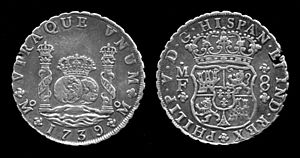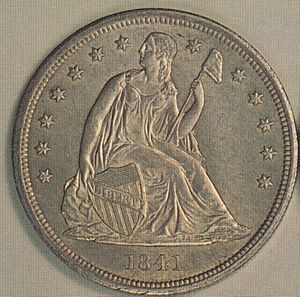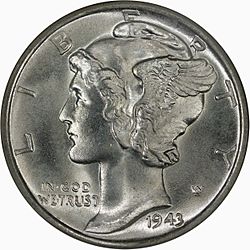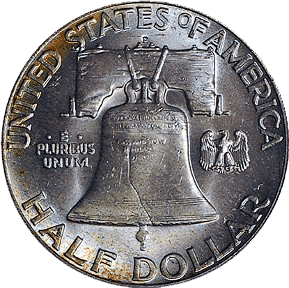Numismatic history of the United States facts for kids
The story of money in the United States began with coins from the Colonial times, like the "pine tree shilling." People also used paper money. A very important coin was the Spanish piece of eight. This coin was used a lot and was the ancestor of the U.S. Dollar we use today.

The United States government didn't start printing its own paper money until 1861.
Contents
Early American Coins (1792 - 1837)
In 1792, a law called the Coinage Act of 1792 created the United States Mint. This was the place where U.S. coins would be made. The law also decided what coins would be made and their values.
Here are some of the first coins:
- Half Cent: Worth 1/200 of a dollar.
- Cent: Worth 1/100 of a dollar.
- Half Dime: Worth five cents.
- Dime: Worth 10 cents.
- Quarter: Worth 25 cents.
- Half Dollar: Worth 50 cents.
- Dollar: Worth one dollar.
- Quarter Eagle: Worth $2.50 (gold coin).
- Half Eagle: Worth $5 (gold coin).
- Eagle: Worth $10 (gold coin).
The very first official U.S. coin made under this law was the half disme (half dime). A popular story says these first half dimes were made from Martha Washington's own silverware!
The half cent and cent coins were made of pure copper. The half dime, dime, quarter, half dollar, and dollar coins were made of 90% silver. The gold coins (Quarter Eagle, Half Eagle, and Eagle) were made of mostly gold. All these early coins showed Liberty on the front and a bald eagle on the back.
Over the years, the designs changed. For example, the Draped Bust design was used on many copper and silver coins from 1796 to 1807. Sometimes, years would pass without a certain coin being made.
New Designs and Coins (1836 - 1891)
The United States Seated Liberty coinage was a popular silver coin design in the mid-to-late 1800s. It was the first U.S. coin to show a seated portrait. The first Seated Liberty coin, a dollar, appeared in 1836. Dimes, half dimes, quarters, and half dollars with this design followed soon after.
In 1849, after the California Gold Rush brought lots of gold, a new $20 gold coin was added. This coin was called the Double Eagle. It contained almost a full ounce of gold. Many of these coins were made and still exist today.
The size of the cent coin changed because copper prices went up. Before, cents were large and heavy. Between 1856 and 1857, they were replaced by smaller coins. The first small cent was the Flying Eagle cent, made of copper and nickel. In 1859, this was replaced by the Indian Head cent. By 1864, during the American Civil War, copper and nickel prices rose again. The cent became thinner and was made of bronze (copper without nickel).
The five-cent nickel coin was introduced in 1866. This new coin slowly made the half dime useless. The nickel coin still has the same metal mix today: about 25% nickel and 75% copper.
The second half of the 1800s also saw some unusual coin values. The two cent piece was made from 1864 to 1873. It was the first American coin to say "In God We Trust" on it. This phrase was added because of stronger religious feelings during the Civil War. Three cent pieces (made of silver, then copper-nickel) were also made. From 1875 to 1878, Twenty cent pieces were made with the Seated Liberty design. A Three-dollar piece made of gold was also minted from 1854 to 1889.
In 1878, the first Morgan Silver Dollars were made. This coin series lasted until 1904 and was made again for a short time in 1921.
New Century Coins and Paper Money (1892 - 1932)
In 1892, new designs by Charles E. Barber appeared on the dime, quarter, and half dollar. His Liberty Head nickel had already started in 1883. So, from 1892 to 1904, his designs were on almost all coins from 5 cents to one dollar. The Barber designs stayed on dimes and quarters until 1916, on half dollars until 1915, and on the nickel until 1913.
Federal Reserve Notes (our modern paper money) were first issued in 1917. These notes were originally backed by gold. This meant you could, in theory, exchange a paper note for a gold coin at a bank. This changed in 1933 when gold coins were taken out of public use. Silver certificates could be exchanged for silver coins until June 1968.
The design of the One dollar bill has stayed almost the same since 1935. Other paper money designs were similar until they were updated in the late 1990s.
The Gold Eagle coin was redesigned in 1907 as the Indian Head eagle. The $2.50 and $5 gold coins followed in 1908. The Liberty Head Double Eagle was replaced by the St. Gaudens Double Eagle in 1907. The wheat penny, with Abraham Lincoln's face on the front, was introduced in 1909. The wheat penny was the first American coin to show the face of a real person, not just Liberty. Also, the Buffalo nickel and Mercury dime were both introduced in the 1910s.
The Peace Dollar was made from 1921 to 1935. After 1935, the U.S. Mint stopped making silver dollars for everyday use. Dimes, quarters, and half dollars, which were 90% silver, were replaced with copper-nickel coins after 1964. From 1965 to 1976, some coins had 40% silver. After 1977, no precious metals were used in regular coins until special collector coins started in the 1980s.
Modern Coins and the End of Silver (1933 - 1998)
After 1933, the United States stopped making gold coins and silver dollars for general use. This was due to a government order. Paper money then took the place of coins worth more than 50 cents. Until 1964, dimes, quarters, and half dollars were still made with 90% silver. Half dollars had 40% silver from 1965 to 1970.
A new tradition began with the 1909 Lincoln cent: putting past presidents and Founding Fathers on coins. This continued in the 1930s and 1940s:
- The Washington quarter in 1932.
- The Jefferson nickel in 1938.
- The Roosevelt dime in 1946.
- The Franklin half dollar in 1948.
The Washington quarter design stayed mostly the same until 1998, except for the silver being removed. The Jefferson nickel design lasted until 2003, and the Roosevelt dime design is still used today. The Franklin half dollar was replaced by the John F. Kennedy half dollar in 1964 to honor him after he was murdered. The Kennedy half dollar's silver content changed from 90% to 40% in 1965, and then to copper-nickel after 1970.
The last regular coins made with 90% silver are dated 1964. In 1982, the penny's copper was mostly removed. Now, pennies are mainly made of zinc with a thin copper coating.
The designs of U.S. paper money were updated in the late 1990s and early 2000s to help stop counterfeiting (fake money).
Today's Coins (1999 to Present)
American coins and paper money have changed a lot since the late 1990s. Before then, U.S. money had not changed much since silver coins ended in the mid-1960s. Some coins, like the nickel, and paper money had barely changed since the 1930s.
Starting in 1996 with the $100 and $50 bills, paper money was redesigned to prevent counterfeiting. In 1999, the State Quarter program began, changing the classic Washington quarter design. Then came the 2004 nickels, which celebrated the 200th anniversary of the Lewis and Clark Expedition. The cent was redesigned in 2009 to honor Abraham Lincoln's 200th birthday. After 2009, the Shield Penny design, showing how Lincoln kept the country united, appeared on the back of pennies.
The dollar coin returned in 1999 with the Susan B. Anthony dollar. This was followed by the Sacagawea dollar in 2000. The Presidential dollar series, which honored past presidents, ended in 2016. The American Innovation dollar was introduced in late 2018.





